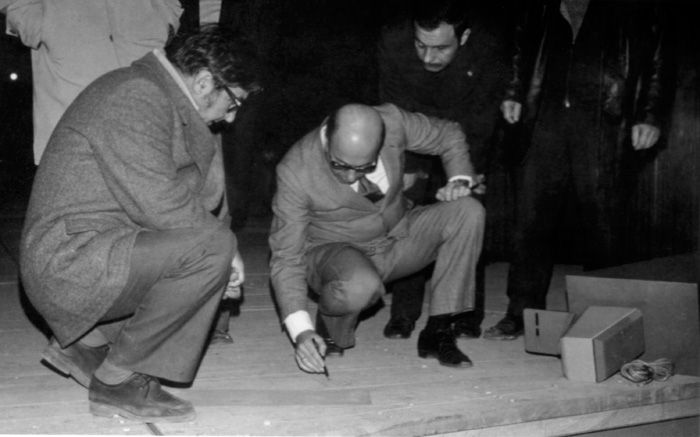AKM Reunion
Salt Galata
October 9, 2012 18.30

Hayati Tabanlıoğlu at the construction site of Atatürk Kültür Merkezi, 1970s
SALT Galata, Auditorium
Speakers: Aydın Boysan and Johannes Dinnebier
Moderators: Pelin Derviş and Gökhan Karakuş
The first of a series of events organized in parallel to the exhibition The Performance of Modernity: ATATÜRK KÜLTÜR MERKEZI, 1946-1977 is the “AKM Reunion,” which will take place in the Auditorium at SALT Galata on October 9. Moderated by the curators of the exhibition Pelin Derviş and Gökhan Karakuş, the gathering will host two of the key actors involved in the making of the Atatürk Kültür Merkezi (AKM/Ataturk Cultural Center): architect Aydın Boysan and lighting designer Johannes Dinnebier.
Boysan and Dinnebier were among the avant-garde practitioners invited to contribute to the project by the architect and head supervisor of the AKM project Hayati Tabanlıoğlu. Leading figures in their respective fields, the speakers will cite the intricacies behind the design and construction of AKM in the context of post-war Turkey.
Aydın Boysan is one of the leading figures of 20th century architecture in Turkey. Known for his extensive work in the design of industrial buildings, Boysan was also one of the leaders in professional architectural practice as the first director of the Chamber of Architects of Turkey. His prolific architectural production from the 1950s to 1980s was marked by the design of a large number of buildings for industry using a structurally expressive language of reinforced concrete, steel, aluminum, glass and fiberglass. One of the best examples of his approach is the Arçelik Çayırova Factory, Istanbul, 1967, which used a modular system of raking triangular forms to generate a rich, articulated façade. His participation in the construction of AKM was through his association with Arçelik, which was responsible for the building’s iconic aluminum façade.
Johannes Dinnebier was a key figure in the design and development of lighting systems in Germany from the 1950s to the present and worked on public spaces such as churches, airports, corporate lobbies, concert and meeting halls. Not trained as a designer, Dinnebier started to work in lighting as a manufacturer of domestic lighting fixtures in post-war German reconstruction, repurposing the military production of steel and aluminum for civil use. The commercial success of his designs led to close working relationships with architects who came to his firm Dinnebier Licht, located in Düsseldorf and Wuppertal, to find a collaborator to work on customized lighting solutions for their designs. Dinnebier’s approach was to focus on creating extensive fields of light using reflective surfaces and glass with optics. The arrays of light he designed were characterized by the modular use of elements in complex geometrical patterns. His work at AKM in İstanbul, which included reflective glass chandeliers, ceiling lighting and sculptures was typical of Dinnebier’s all-encompassing approach.
The talks will be held in Turkish and German, with simultaneous translation into German and Turkish respectively.

